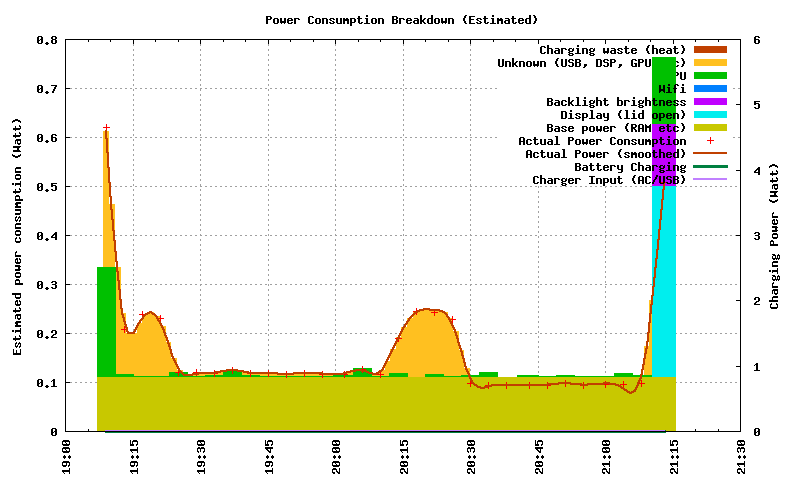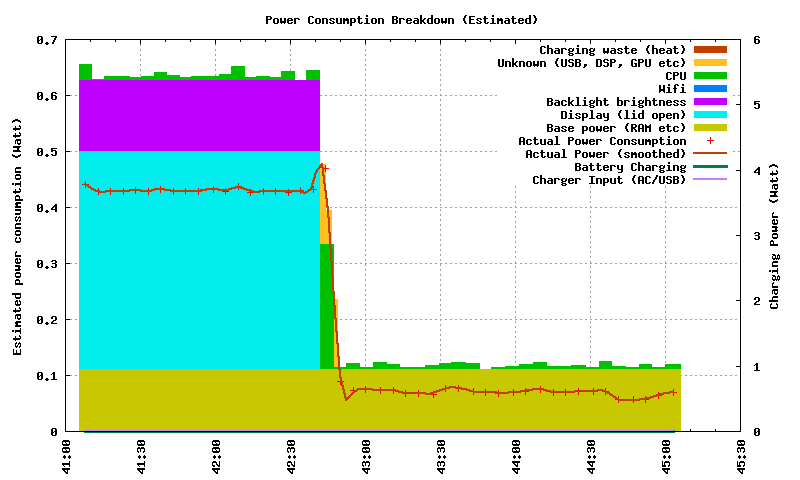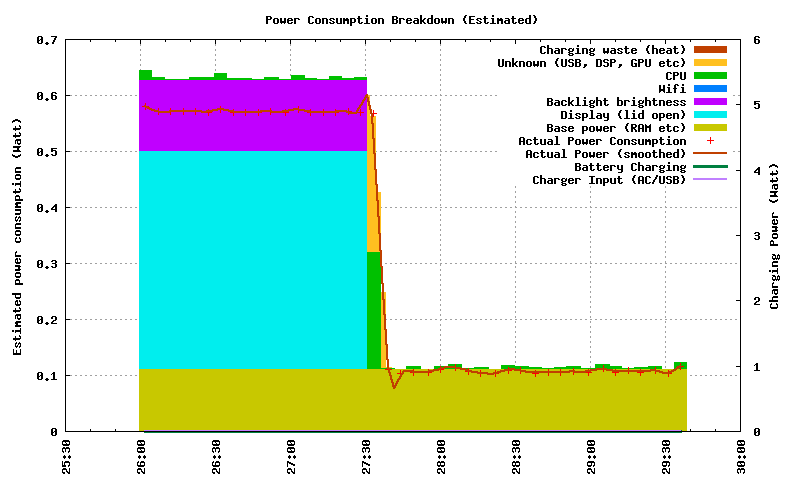Try underclocking more. SZ uses the TI recommended thresholds, so it goes to max OPP pretty quickly.I was reading this in another topic:
is it supposed to do so now? I am on SZ 1.60 and it only shows e.g. OPP5/5 - I see no dmesg about OPP other than setting max now...dmesg | grep OPP | tail -n 1 and then some awk magic works well enough. The next sysinfo will give both the max and current OPP value, e.g. on my ReBirth unit it shows things like "250 MHz (OPP 2/5)" now...
You are using an out of date browser. It may not display this or other websites correctly.
You should upgrade or use an alternative browser.
You should upgrade or use an alternative browser.
Release Pandora System Info
- Thread starter _wb_
- Start date
sepulep
Member
- Joined
- Nov 18, 2008
- Messages
- 367
it reports OPP5/5 at 600 mhz ??Try underclocking more. SZ uses the TI recommended thresholds, so it goes to max OPP pretty quickly.I was reading this in another topic:
is it supposed to do so now? I am on SZ 1.60 and it only shows e.g. OPP5/5 - I see no dmesg about OPP other than setting max now...dmesg | grep OPP | tail -n 1 and then some awk magic works well enough. The next sysinfo will give both the max and current OPP value, e.g. on my ReBirth unit it shows things like "250 MHz (OPP 2/5)" now...
Yes, that is normal. For the SoC used by ReBirth units, TI recommends OPP5 starting from 600MHz, OPP4 above 500MHz, OPP3 above 250MHz, OPP2 above 125MHz. Don't worry about CPU lifetime or battery life though -- thanks to power saving, your CPU is effectively powered off most of the time, so the OPP setting barely matters at all.
OPP5 should be the default for a while now. 600 MHz at OPP3 is undervolting.
notaz
Certified Guru
I've found a way to save a bit more power in lid-close state:

The "middle mountain" is me issuing some register changes through serial.
Stay tuned for a firmware update. Hopefully it doesn't break anything..
_wb_: It would be nice if logging avoided writes to SD card, like do a write only when logging stops or at least every few minutes. Or write to /tmp/ and then move the file. Right now turning on the SD controller for the writes tends to screw up low power tests, even when interval is large, so I had to symlink logs/ to /tmp/ .

The "middle mountain" is me issuing some register changes through serial.
Stay tuned for a firmware update. Hopefully it doesn't break anything..
_wb_: It would be nice if logging avoided writes to SD card, like do a write only when logging stops or at least every few minutes. Or write to /tmp/ and then move the file. Right now turning on the SD controller for the writes tends to screw up low power tests, even when interval is large, so I had to symlink logs/ to /tmp/ .
Last edited by a moderator:
- Joined
- Dec 8, 2005
- Messages
- 6,603
- Age
- 42
- Location
- UK
- Website
- pokeparadox.itch.io
- WEBSITE
- https://github.com/pokeparadox
- YOUTUBE
- pokeparadox
Nice.. although can you tell us what it is you've found that saves a bit more? 
Cool! Looks like you got the consumption below 0.1W -- that probably adds a day or so of standby time.I've found a way to save a bit more power in lid-close state:

The "middle mountain" is me issuing some register changes through serial.
Stay tuned for a firmware update. Hopefully it doesn't break anything..
What did you do? Does it only have an effect with the lid closed or could it also save a little power with the lid open?
Yes, this is a problem indeed. Writing only when logging stops or writing to /tmp/ has the disadvantage that all is lost when a crash happens. Is there an easy way to do write caching in RAM that is longer than the default writeback time? I guess not. I'll do it manually by writing to /tmp/ and only periodically do an append from /tmp/ to the actual log file._wb_: It would be nice if logging avoided writes to SD card, like do a write only when logging stops or at least every few minutes. Or write to /tmp/ and then move the file. Right now turning on the SD controller for the writes tends to screw up low power tests, even when interval is large.
(for now, you could avoid the problem by making appdata/sysinfo a symlink to somewhere in /tmp/)
porg
Active Member
Already suggested that long ago, nice that @_wb_ picks this up nowIt would be nice if logging avoided writes to SD card […]
notaz
Certified Guru
Disabling 26MHz clock in PMIC. Only can be done when idle, the clock is otherwise needed for almost everything on OMAP..Nice.. although can you tell us what it is you've found that saves a bit more?
You can try calling setvbuf() with _IOFBF and really large buffer, then call fflush() to write it out at will.Is there an easy way to do write caching in RAM that is longer than the default writeback time?
If you go on like this you will make the Pandora produce power by itselfI've found a way to save a bit more power in lid-close state:

The "middle mountain" is me issuing some register changes through serial.
Stay tuned for a firmware update. Hopefully it doesn't break anything..
_wb_: It would be nice if logging avoided writes to SD card, like do a write only when logging stops or at least every few minutes. Or write to /tmp/ and then move the file. Right now turning on the SD controller for the writes tends to screw up low power tests, even when interval is large, so I had to symlink logs/ to /tmp/ .
Hồng Thất Công
Đả Cẩu Bổng Pháp
Always nice to see my panda breathes longer 
Last edited by a moderator:
notaz
Certified Guru
BTW _wb_, with latest firmware update there is now reliable way to detect the model without relying on default sysclock and what SGX drivers report, it's some new files in /sys/bus/soc/devices/soc0/* . This has been backported from newer kernels.
On unrelated note, one interesting thing is that my CC unit seems to be really good at power saving:

It has one of the sample screens, not the ones used in mass production.
For comparison, here is my 1GHz:

It also seems to be drawing more than the last time I did measurements. Maybe it's because the battery is fully charged now and the voltage from it is higher?
On unrelated note, one interesting thing is that my CC unit seems to be really good at power saving:

It has one of the sample screens, not the ones used in mass production.
For comparison, here is my 1GHz:

It also seems to be drawing more than the last time I did measurements. Maybe it's because the battery is fully charged now and the voltage from it is higher?
Oh, nice that there's an easier model check now.
I should probably make power breakdown graph in mA, not in mW, since everything probably draws its current regardless of voltage.
I should probably also take the indicator leds into account. They consume a noticeable amount of power.
I should probably make power breakdown graph in mA, not in mW, since everything probably draws its current regardless of voltage.
I should probably also take the indicator leds into account. They consume a noticeable amount of power.
notaz
Certified Guru
That's not really true, from my observations mA values tend to increase as the battery discharges, so it should be correct now.I should probably make power breakdown graph in mA, not in mW, since everything probably draws its current regardless of voltage.
Last edited by a moderator:
notaz
Certified Guru
When all pending stuff is integrated (like icons from ekianjo) and ED finds a minute to upload the release.
I'm happy to upload as soon as everything is finished  GC needs new SD Cards anyways, so the faster the better
GC needs new SD Cards anyways, so the faster the better 
slaeshjag
¯\_(ツ)_/¯
Are you suggesting that I start working on that? 
Similar threads
- Replies
- 0
- Views
- 2K
- Replies
- 44
- Views
- 12K

